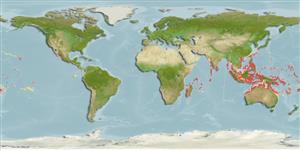>
Gobiiformes (Gobies) >
Gobiidae (Gobies) > Gobiinae
Etymology: Exyrias: Derived from Greek, xyreo = to shave (Ref. 45335); belissimus: Genus misspelled..
More on author: Smith.
Environment: milieu / climate zone / depth range / distribution range
Ecologia
marino associati a barriera corallina; distribuzione batimetrica 1 - 30 m (Ref. 90102). Tropical; 30°N - 30°S
Indo-West Pacific: East Africa to Samoa, north to Yaeyama Islands, south to Fiji.
Size / Peso / Age
Maturity: Lm ? range ? - ? cm
Max length : 15.0 cm SL maschio/sesso non determinato; (Ref. 48637)
Spine dorsali (totale): 7; Raggi dorsali molli (totale): 10-12; Spine anali 1; Raggi anali molli: 9 - 10; Vertebre: 26. Dorsal half of body brown, ventral half yellow, with 7-8 dark brown bars. Small silvery white spots on cheeks and opercula. Predorsal scales 8 or 9. Usually, spines on 1st dorsal fin elongated into filaments with the 3rd and 4th typically longest; spine of 2nd dorsal fin with red and white alternating bands, spots on rays and membrane. Cycloid scales only on nape and isthmus. Cheeks and opercula fully scaled. Teeth small and tightly packed in jaws. Depth of body about 3.6-3.9 in SL (Ref. 90102).
A territorial species that inhabits lagoon and seaward reefs (Ref. 9710, 48637). Found over silty bottoms near or under overhanging corals. Feeds by sifting the sediment through its gill rakers (Ref. 1602).
Life cycle and mating behavior
Maturità | Riproduzione | Deposizione | Uova | Fecundity | Larve
Murdy, E.O., 1985. A review of the gobiid fish genera Exyrias and Macrodontogobius, with description of a new species of Exyrias. Indo-Pac. Fish. (10):14 p. (Ref. 403)
IUCN Red List Status (Ref. 130435)
Threat to humans
Harmless
Human uses
Acquario: Commerciale
Informazioni ulteriori
Nomi ComuniSinonimiMetabolismoPredatoriEcotossicologiaRiproduzioneMaturitàDeposizioneSpawning aggregationFecundityUovaEgg development
BibliografiaAcquacolturaProfilo di acquacolturaVarietàGeneticaElectrophoresesEreditarietàMalattieElaborazioneNutrientsMass conversion
Strumenti
Special reports
Download XML
Fonti Internet
Estimates based on models
Preferred temperature (Ref.
123201): 26.2 - 29.3, mean 28.6 °C (based on 2723 cells).
Phylogenetic diversity index (Ref.
82804): PD
50 = 0.5312 [Uniqueness, from 0.5 = low to 2.0 = high].
Bayesian length-weight: a=0.00708 (0.00390 - 0.01284), b=3.05 (2.89 - 3.21), in cm total length, based on LWR estimates for this species & (Sub)family-body (Ref.
93245).
Trophic level (Ref.
69278): 2.8 ±0.30 se; based on food items.
Resilienza (Ref.
120179): Medio, tempo minimo di raddoppiamento della popolazione 1.4 - 4.4 anni (Preliminary K or Fecundity.).
Fishing Vulnerability (Ref.
59153): Low vulnerability (10 of 100).
Nutrients (Ref.
124155): Calcium = 88.7 [47.7, 165.5] mg/100g; Iron = 0.717 [0.373, 1.276] mg/100g; Protein = 18.3 [16.3, 20.0] %; Omega3 = 0.134 [0.064, 0.222] g/100g; Selenium = 23.6 [13.5, 44.1] μg/100g; VitaminA = 117 [31, 370] μg/100g; Zinc = 1.84 [1.26, 2.67] mg/100g (wet weight);
